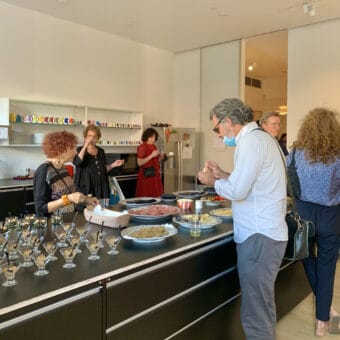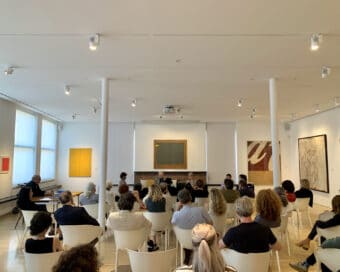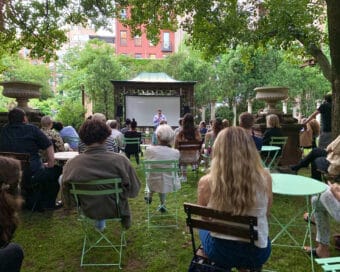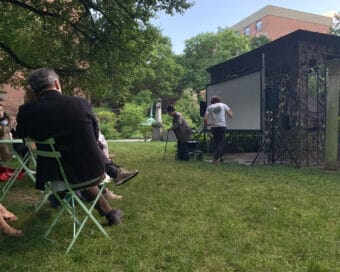Written by CIMA’s Summer 2021 Intern, Gizelle Greeley Winter.
On Wednesday, June 23rd, CIMA hosted its first in-person event since the start of the COVID-19 pandemic: an interview with poet, photographer, and filmmaker Gerard Malanga, which segued into a reading and book signing of his latest poetry collection The New Mélancholia (published in March of 2020 by Bottle of Smoke Press) and a screening of his 1967 film In Search of the Miraculous at Elizabeth Street Garden. This event was free and open to the public — we hope that it will herald a new era of vibrant in-person events as the world begins to safely reopen. Guests began trickling into our spacious SoHo loft at 6:00, where they were offered appetizers and beverages before settling into socially distanced seats in the main gallery.
Gerard Malanga is committed to writing poetry every day of his life. He has published multiple poetry books over the past 50 years, including Chic Death (1971), Mythologies of the Heart (1996), No Respect (2001), and Cool & Other Poems (2019). He was one of Andy Warhol’s “superstars,” a chief assistant in Warhol’s Factory who significantly contributed to Warhol’s silkscreens and films. He is also a renowned photographer, whose portraits and iconic shots have long been subject to professional collection. Throughout his creative career, Malanga has been surrounded by other creatives — including this year’s CIMA headliner, Mario Schifano.
CIMA fellow Carlotta Vacchelli, who was almost exclusively responsible for organizing this event, said as much in her introduction. She introduced Malanga as an “emblematic protagonist of the New York underground scene in the ’60s and ‘70s… a multifaceted and prolific author whose works intersect multiple genres and intellectual milieus.” She then summarized his poetry style in The New Mélancholia, saying:
Poetry and friendship are constantly blurred in the reflections of Mr. Malanga, who seems to consider poetry primarily as an encounter of souls across time and space, and a matter of shared sensibilities. Not by chance, poetry is found also in other genres, like jazz and rock music, cinema, and, naturally, painting, which makes CIMA and our current exhibition on Mario Schifano the ideal theater for today’s reading.
Before cracking open The New Mélancholia, Malanga remarked on his environment, which consisted of the jaw-dropping works of his close friend Mario Schifano. Indeed, the presence of a beloved friend seemed to enliven Schifano’s paintings and vice versa. Among others, he chose to read poems titled “Cousin, Marianna,” “March 9th 2020,” “Cy Twombly, artist, 1928-2011,” “The New Mélancholia,” and “Dear Nicola, Nicki for short.” A short excerpt from the latter is provided below:
Dear Nicola,
Clearing out the clutter from my office this lone wintry day,I came upon a receipt, actually 2 receipts—we split the check— for the one and only lunch
we ever had, The Smith
across from Lincoln Center
… and then you walked me over to the Park
the Tavern on the Green,
to catch my ride home to the Kaaterskills,
& I sensed we’d never see each other again which turns out mostly true & worth at least another hundred years of memory outliving us& add to that another hundred worth of poésie. (The New Mélancholia, p. 137)
As the last lines of Malanga’s poetry echoed throughout our gallery, our fellows opened the floor to audience members for a Q&A session. Some wondered about Malanga’s origins as a poet and learned that he was ushered into the art by his high school English teacher, Ms. Daisy. She used to invite prominent poets to read their poetry in class, which may have encouraged Malanga’s interest in spoken-word poetry. Others wondered how his work had been affected by the COVID-19 pandemic, especially since The New Mélancholia was published at its peak. Malanga replied that “some of my poems feature a longing to return to England during a time when travel was impossible. As a result of the pandemic, these poems are full of longing.” One particularly notable question prompted Malanga to define the relationship between poetry and nostalgia — he responded by saying, “Well, it’s love… I’m writing about the person I love. I’m putting love into my writing and touching people’s hearts, and I think that’s an expression of nostalgia.” Finally, and fittingly, Malanga was asked to further explain his connection to Schifano, and he said, “We recognized something in each other — the creative spirit. If you had an idea, [Mario] would say, ‘yes, let’s do it!’ … I thought Mario was a very unique artist… he connected with the American Art scene very quickly.”
As the Q&A came to a close, guests made their way over to Elizabeth Street Garden, while the sun began to set and summer heat began to dissipate. Elizabeth Street Garden is just 10 minutes West of CIMA: it’s a charming community garden, characterized by statues and adorably overgrown topiaries. Unfortunately, this lovely garden is in danger of being developed, as explained by Executive Director Joseph Reiver in his introductory welcome speech. Elizabeth Street Garden is free and open to the public — it provides much-needed green space, and adds character to SoHo. If you’d like to contribute to their fight against development, visit their website at https://www.elizabethstreetgarden.com.
After a brief secondary introduction by our Education and Programs Manager Nicola Lucchi, Malanga rose to present his 29-minute film In Search of the Miraculous, to which Schifano contributed. For the film’s program, Donatella Manganotti writes,
In Search of the Miraculous is a multi-leveled story realized with extremely personal techniques and with the kind of atmosphere of Poetry and Introspection, only a poet could create. It is, in fact, the story of a poet searching himself through his love for a girl, and of the girl searching for her father. Obsequious to the iron rules of the avant-garde, the film has neither a beginning nor an ending. It is a series of moods, it is a search which is at the same time spiritual and concrete, it is a moment in the life of two people.
When Malanga’s film was first presented at the 1967 edition of the Bergamo Film Festival, Italian novelist Alberto Moravia described it as “a series of images strangely beautiful and revealing” — that description couldn’t be more accurate. The film opens with a shot of spinning bodies, dancing energetically on the geometric tiles of Columbia’s campus: these are overlaid with nearly transparent scenes of domesticity, which juxtapose wide open spaces with enclosed ones. The bricks of New York City provide backdrops for cloudy black and white portraits; then, these immobile portraits are cast with a dreamlike series of moving colors and lights that seems to revitalize each figure, creating the illusion of dynamism. While these “strangely beautiful and revealing” images dart across the screen, the audience listens to a uniquely curated soundtrack, one that features Italian opera and soft rock alike. Notably, most of the songs are incredibly popular within their respective genres, which creates a sense of familiarity for the audience members that recognize their lyrics or melodys.
All this to say, the evening was filled with provocation and stimulus. Our guests were encouraged to feel, to listen and reflect, to ponder the meaning of friendship, of nostalgia, and of love. That reflection aligned perfectly with our excitement at reopening our space to the CIMA family, and fell neatly in line with the spirit of our ongoing “Schifano and Friends” series. CIMA will continue to organize in-person events throughout the summer, among them several film screenings at Elizabeth Street Garden. Be sure to join us next time!




